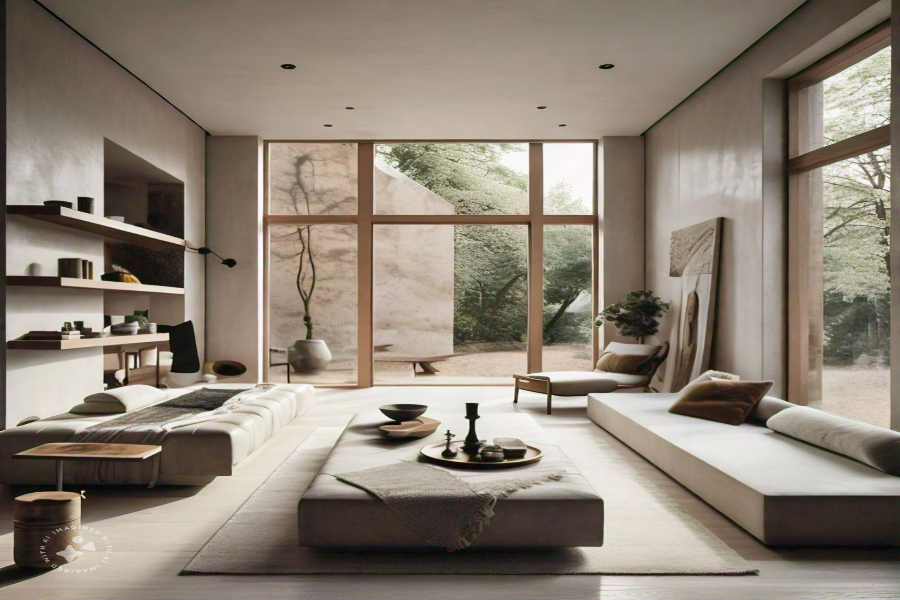In a world overflowing with excess and complexity, minimalism offers a refreshing approach to home design. Rooted in the idea that “less is more,” minimalism emphasizes simplicity, functionality, and elegance. This design philosophy seeks to create a serene and uncluttered space that promotes both physical and mental well-being. In this blog, we’ll explore the principles of minimalism in home design, how to implement them, and the benefits of creating a clutter-free space.
What is Minimalism in Home Design?
Key principles of minimalism include:
1. Simplicity
Minimalist design is defined by simplicity. This means opting for straightforward forms, streamlined shapes, and avoiding unnecessary embellishments. Furniture and decor are chosen for their functionality and clean aesthetics.
2. Functionality
Every item in a minimalist home serves a purpose. Furniture and decor are selected based on their practical use and contribution to the overall design. This focus on functionality helps to reduce clutter and maintain a sense of order.
3. Neutral Color Palette
Minimalist spaces often feature a neutral color palette, including whites, grays, and beiges. These colors create a calm and cohesive environment, making the space feel more open and airy. Accents and textures can be added in subtle ways to maintain visual interest without overwhelming the space.
4. Decluttering
A fundamental aspect of minimalism is decluttering. This involves removing excess items and organizing what remains. The aim is to create an environment where only the most meaningful and functional objects are present.
Implementing Minimalism in Your Home
Transitioning to a minimalist home design may seem daunting, but with a few strategic steps, you can create a clutter-free space that embodies minimalist principles.
1. Start with a Plan
Begin by assessing your current space and identifying areas that need decluttering. Make a list of the rooms or zones where you want to apply minimalist principles. This plan will help guide your efforts and ensure a focused approach.
2. Declutter and Simplify
Go through your belongings and evaluate each item based on its usefulness and significance. Keep only what you truly need or love. Donate or sell items that no longer serve a purpose. Implement smart storage solutions to keep essentials organized and out of sight.
3. Choose Quality Over Quantity
Invest in high-quality, timeless furniture and decor pieces that will stand the test of time. Focus on fewer, well-crafted items rather than accumulating a large number of possessions. This approach not only enhances the aesthetic appeal but also contributes to a more sustainable lifestyle.
4. Embrace Open Space
Minimalist design often features open, unobstructed spaces. Arrange furniture and decor to promote flow and avoid crowding. Keep surfaces clear and utilize hidden storage options to maintain a clean and uncluttered look.
5. Use Natural Light
Maximize natural light to create an airy and inviting atmosphere. Avoid heavy drapes and opt for light, sheer window treatments that allow sunlight to filter through. Natural light enhances the sense of openness and contributes to a calming environment.
6. Incorporate Textures and Accents
While minimalism emphasizes simplicity, it doesn’t mean sacrificing style. Incorporate textures and subtle accents to add warmth and character to the space. Use natural materials like wood, stone, or metal to introduce depth and interest without overwhelming the design.
7. Maintain Regularly
A minimalist home requires ongoing maintenance to stay clutter-free. Establish routines for tidying up and organizing to prevent clutter from accumulating. Regularly reassess your belongings and make adjustments as needed to keep the space aligned with minimalist principles.
The Benefits of Minimalism
Adopting a minimalist approach to home design offers numerous benefits beyond just a visually pleasing space.
1. Reduced Stress
A clutter-free environment promotes a sense of calm and reduces stress. By eliminating unnecessary distractions and organizing your space, you create a more serene and peaceful living environment.
2. Improved Focus
Minimalism helps eliminate visual noise, allowing you to focus better on tasks and activities. With fewer distractions, you can enhance productivity and create a more efficient living space.
3. Enhanced Aesthetics
Minimalist design creates a sophisticated and timeless aesthetic. Clean lines, neutral colors, and thoughtfully chosen decor contribute to a harmonious and elegant look.
4. Increased Functionality
By prioritizing functionality, minimalism ensures that every item in your home serves a purpose. This approach leads to a more practical and efficient use of space.
5. Environmental Benefits
Minimalism encourages mindful consumption and sustainability. By investing in quality items and reducing excess, you contribute to a more eco-friendly lifestyle.
Minimalism in home design is about creating a space that reflects simplicity, functionality, and elegance. By embracing decluttering, focusing on quality, and maintaining a neutral color palette, you can transform your home into a serene and organized retreat. The benefits of minimalism extend beyond aesthetics, offering improved well-being, increased focus, and a more sustainable lifestyle. Embrace the minimalist philosophy to create a clutter-free space that enhances both your home and your life.








